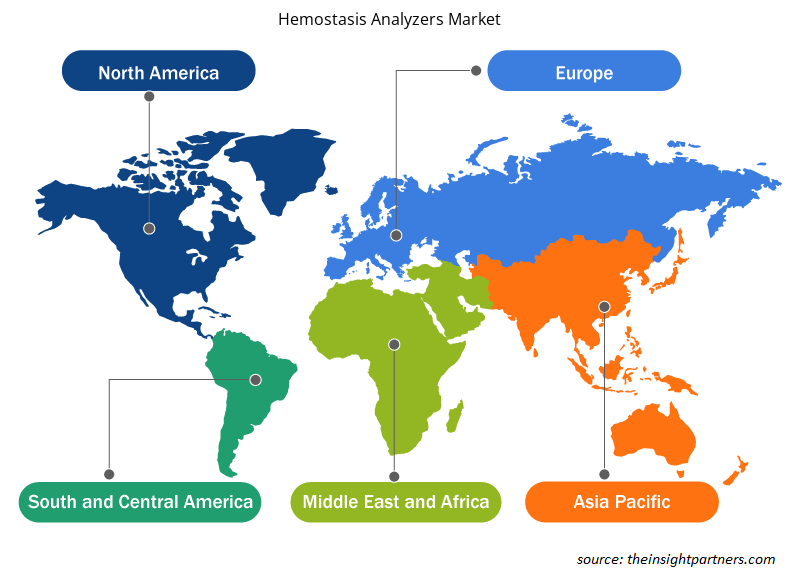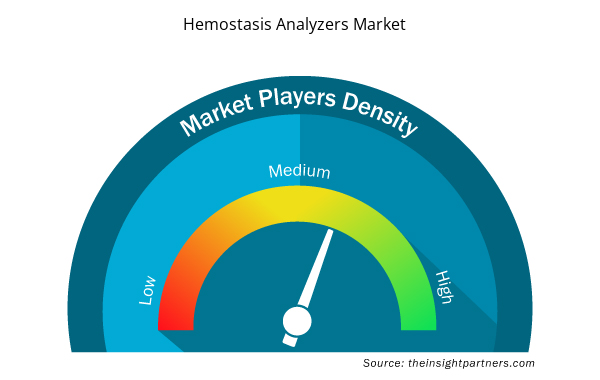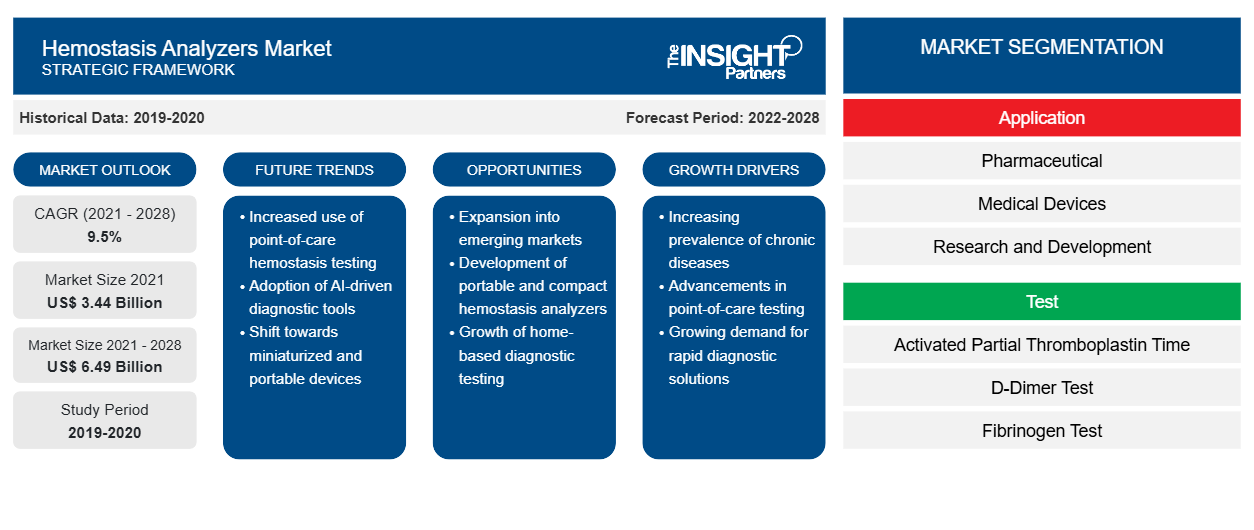凝血分析仪市场规模预计将从 2021 年的 34.4066 亿美元增至 2028 年的 64.9024 亿美元;预计 2021 年至 2028 年的复合年增长率为 9.5%。
止血分析仪可快速简便地测量血小板水平。凝血测试有助于检测和预防可能导致心脏病发作的血栓。凝血分析仪可以在几分钟内测量凝血途径的速度以及凝血酶和凝血活酶的量。心血管疾病 (CVD) 可能仍然是全球发病率和死亡率的最重要原因。CVD 是心脏和血管疾病,包括脑血管病、冠心病、风湿性心脏病和其他疾病。导致心血管疾病和困难的一些生活方式相关问题是吸烟、不健康饮食和缺乏身体活动。它们会增加心脏病发作和中风的风险。心血管疾病的其他风险因素包括高血压、糖尿病和胆固醇水平升高。根据世界卫生组织 (WHO) 的数据,心血管疾病是全球第一大死亡原因。
定制此报告以满足您的需求
您可以免费定制任何报告,包括本报告的部分内容、国家级分析、Excel 数据包,以及为初创企业和大学提供优惠和折扣
- 获取此报告的关键市场趋势。这个免费样品将包括数据分析,从市场趋势到估计和预测。
市场洞察
老年人口增长推动止血分析仪市场发展
老年人由于免疫力低下和其他健康问题,容易患心脏病。一般的衰老因素会导致心脏和血管僵硬,从而导致心脏疾病。随着年龄的增长,收缩压也会升高,导致心血管疾病 (CVD)。因此,对于 75 岁及以上的人群来说,高血压是心脏病的常见风险因素。其他风险因素包括冠状动脉疾病和心力衰竭。虽然心律失常的发病率涵盖所有年龄段的人,但老年人口的发病率显著上升。
根据 2019 年全球老龄化调查,2019 年全球 65 岁及以上人口总数为 7.03 亿。到 2050 年,老年人口预计将翻一番,达到 15 亿。到 2025 年,65 岁或以上老人的比例可能会从 2019 年的每 11 人中 1 人增加到每 6 人中 1 人。这一人群更容易患心血管疾病,例如心律失常。同样,根据世界卫生组织 (WHO) 的数据,到 2050 年,60 岁及以上人口的比例预计将从 2015 年的 12% 达到 22%。根据联邦老龄化相关统计机构间论坛的报告《2016 年美国老年人:幸福感的关键指标》,35.8% 的 85 岁及以上人士患有轻度或极度认知障碍。此外,根据联合国《2017 年世界人口老龄化报告》,2017 年全球 60 岁及以上人口达 9.62 亿,预计到 2050 年将达到近 21 亿。
老年人口更容易出现非典型症状、合并症和不良后果。这些疾病的主要原因与衰老引起的心血管系统结构和功能变化有关。全球老年人口的增加导致心血管疾病激增,进而推动了对止血分析仪的需求
基于产品类型的洞察
根据产品类型,止血分析仪市场进一步细分为实验室分析仪和即时检测系统。2021 年,实验室分析仪细分市场占据最大市场份额,而即时检测系统细分市场预计在 2021-2028 年期间的复合年增长率最高。
止血分析仪市场份额(按产品类型)——2021 年和 2028 年
基于测试的见解
根据测试,市场细分为活化部分凝血活酶时间、D-二聚体测试、纤维蛋白原测试、凝血酶原时间测试等。2021 年,活化部分凝血活酶时间部分占据了最大的市场份额。凝血酶原时间测试部分预计将在 2021-2028 年期间实现市场最高复合年增长率。
基于最终用户的洞察
根据最终用户,市场细分为医院/诊所、独立诊断实验室、家庭护理环境等。2021 年,医院/诊所部门占据了最大的市场份额。预计独立诊断实验室部门将在 2021-2028 年期间实现最高的复合年增长率。在
止血分析仪市场运营的公司强调采用产品创新战略来满足全球不断变化的客户需求,这也使他们能够在全球市场上保持自己的品牌名称。
止血分析仪市场 – 细分
止血分析仪市场根据产品类型、测试和最终用户进行细分。根据产品类型,止血分析仪市场细分为实验室分析仪和即时检测系统。根据测试,市场进一步细分为活化部分凝血活酶时间、D-二聚体测试、纤维蛋白原测试、凝血酶原时间测试等。根据最终用户,市场细分为医院/诊所、独立诊断实验室、家庭护理环境等。在地理方面,止血分析仪市场细分为北美(美国、加拿大和墨西哥)、欧洲(法国、德国、意大利、英国、西班牙和欧洲其他地区)、亚太地区(澳大利亚、中国、印度、日本、韩国和亚太地区其他地区)、中东和非洲(沙特阿拉伯、南非、阿联酋和 MEA 其他地区)以及南美洲和中美洲(巴西、阿根廷和 SCAM 其他地区)
止血分析仪市场区域洞察
Insight Partners 的分析师已详尽解释了预测期内影响止血分析仪市场的区域趋势和因素。本节还讨论了北美、欧洲、亚太地区、中东和非洲以及南美和中美洲的止血分析仪市场细分和地理位置。

- 获取止血分析仪市场的区域特定数据
止血分析仪市场报告范围
| 报告属性 | 细节 |
|---|---|
| 2021 年市场规模 | 34.4 亿美元 |
| 2028 年市场规模 | 64.9 亿美元 |
| 全球复合年增长率(2021 - 2028) | 9.5% |
| 史料 | 2019-2020 |
| 预测期 | 2022-2028 |
| 涵盖的领域 | 按应用
|
| 覆盖地区和国家 | 北美
|
| 市场领导者和主要公司简介 |
|
市场参与者密度:了解其对商业动态的影响
凝血分析仪市场正在快速增长,这得益于终端用户需求的不断增长,而这些需求又源于消费者偏好的不断变化、技术进步以及对产品优势的认识不断提高等因素。随着需求的增加,企业正在扩大其产品范围,进行创新以满足消费者的需求,并利用新兴趋势,从而进一步推动市场增长。
市场参与者密度是指在特定市场或行业内运营的企业或公司的分布情况。它表明在给定市场空间中,相对于其规模或总市场价值,有多少竞争对手(市场参与者)存在。
在止血分析仪市场运营的主要公司有:
- 西门子股份公司
- 仪器实验室
- 雅培
- 希森美康股份有限公司
- 日本光电公司
免责声明:上面列出的公司没有按照任何特定顺序排列。

- 了解止血分析仪市场的主要参与者概况
公司简介
- 西门子股份公司
- 仪器实验室
- 雅培
- 希森美康股份有限公司
- 日本光电公司
- 赛默飞世尔科技公司
- 罗氏诊断
- 诊断学公司Stago
- 海伦娜实验室
- 国际Technidyne公司。
- 历史分析(2 年)、基准年、预测(7 年)及复合年增长率
- PEST 和 SWOT 分析
- 市场规模价值/数量 - 全球、区域、国家
- 行业和竞争格局
- Excel 数据集


- Ketogenic Diet Market
- Power Bank Market
- Pharmacovigilance and Drug Safety Software Market
- Long Read Sequencing Market
- Customer Care BPO Market
- Embolization Devices Market
- Quantitative Structure-Activity Relationship (QSAR) Market
- Compounding Pharmacies Market
- Vision Guided Robotics Software Market
- Aircraft Wire and Cable Market

Report Coverage
Revenue forecast, Company Analysis, Industry landscape, Growth factors, and Trends

Segment Covered
This text is related
to segments covered.

Regional Scope
North America, Europe, Asia Pacific, Middle East & Africa, South & Central America

Country Scope
This text is related
to country scope.
常见问题
The Asia Pacific is expected to be the fastest-growing region and is likely to expand at a high growth rate due to the rising development in the pharmaceutical sector. Also, the rise in the incidence of cardiovascular diseases is likely to provide more significant growth opportunities to the market players in the coming years is likely to boost the growth of the market in the Asia Pacific region.
The global hemostasis analyzers market based on product is segmented into product type [laboratory analyzer (automated systems, semi-automated systems, and manual systems) and point-of-care testing systems. In 2021, the laboratory analyzer segment held the largest share of the market by product and point-of-care testing systems is expected to witness the fastest CAGR during 2021 to 2028.
The global hemostasis analyzers market is segmented into North America, Europe, Asia Pacific, Middle East & Africa, and South & Central America. In the North America region, the market for hemostasis analyzers market is primarily held by the US among the other countries. The growth of the hemostasis analyzers market in the United States is expected to grow owing to increasing organic developments by the market players in the market, rising awareness among consumers for treatment, and an increase in the prevalence of chronic illnesses like blood disorders and cardiovascular diseases.
The hemostasis analyzers market majorly consists of the players such as Siemens AG, Instrumentation Laboratory, Abbott, Sysmex Corporation, Nihon Kohden Corporation, Thermo Fisher Scientific Inc., Roche Diagnostics, Diagnostica Stago, Helena Laboratories, International Technidyne Corporation are amongst others.
Hemostasis analyzers are medical devices that are used to measure the clotting time of hemostasis to detect clotting deficiencies and facilitate the treatment of patients with an excess bleeding condition by medical practitioners.
The factors driving and restraining the hemostasis analyzers market in the coming years include the high prevalence of cardiovascular diseases and the rise in the geriatric population. However, the high cost of a fully automated hemostasis analyzer is likely to hamper the market's growth.
Trends and growth analysis reports related to Life Sciences : READ MORE..
The List of Companies - Hemostasis Analyzers Market
- Siemens AG
- Instrumentation Laboratory
- Abbott
- Sysmex Corporation
- Nihon Kohden Corporation
- Thermo Fisher Scientific Inc.
- Roche Diagnostics
- Diagnostica Stago
- Helena Laboratories
- International Technidyne Corporation
The Insight Partners performs research in 4 major stages: Data Collection & Secondary Research, Primary Research, Data Analysis and Data Triangulation & Final Review.
- Data Collection and Secondary Research:
As a market research and consulting firm operating from a decade, we have published and advised several client across the globe. First step for any study will start with an assessment of currently available data and insights from existing reports. Further, historical and current market information is collected from Investor Presentations, Annual Reports, SEC Filings, etc., and other information related to company’s performance and market positioning are gathered from Paid Databases (Factiva, Hoovers, and Reuters) and various other publications available in public domain.
Several associations trade associates, technical forums, institutes, societies and organization are accessed to gain technical as well as market related insights through their publications such as research papers, blogs and press releases related to the studies are referred to get cues about the market. Further, white papers, journals, magazines, and other news articles published in last 3 years are scrutinized and analyzed to understand the current market trends.
- Primary Research:
The primarily interview analysis comprise of data obtained from industry participants interview and answers to survey questions gathered by in-house primary team.
For primary research, interviews are conducted with industry experts/CEOs/Marketing Managers/VPs/Subject Matter Experts from both demand and supply side to get a 360-degree view of the market. The primary team conducts several interviews based on the complexity of the markets to understand the various market trends and dynamics which makes research more credible and precise.
A typical research interview fulfils the following functions:
- Provides first-hand information on the market size, market trends, growth trends, competitive landscape, and outlook
- Validates and strengthens in-house secondary research findings
- Develops the analysis team’s expertise and market understanding
Primary research involves email interactions and telephone interviews for each market, category, segment, and sub-segment across geographies. The participants who typically take part in such a process include, but are not limited to:
- Industry participants: VPs, business development managers, market intelligence managers and national sales managers
- Outside experts: Valuation experts, research analysts and key opinion leaders specializing in the electronics and semiconductor industry.
Below is the breakup of our primary respondents by company, designation, and region:

Once we receive the confirmation from primary research sources or primary respondents, we finalize the base year market estimation and forecast the data as per the macroeconomic and microeconomic factors assessed during data collection.
- Data Analysis:
Once data is validated through both secondary as well as primary respondents, we finalize the market estimations by hypothesis formulation and factor analysis at regional and country level.
- Macro-Economic Factor Analysis:
We analyse macroeconomic indicators such the gross domestic product (GDP), increase in the demand for goods and services across industries, technological advancement, regional economic growth, governmental policies, the influence of COVID-19, PEST analysis, and other aspects. This analysis aids in setting benchmarks for various nations/regions and approximating market splits. Additionally, the general trend of the aforementioned components aid in determining the market's development possibilities.
- Country Level Data:
Various factors that are especially aligned to the country are taken into account to determine the market size for a certain area and country, including the presence of vendors, such as headquarters and offices, the country's GDP, demand patterns, and industry growth. To comprehend the market dynamics for the nation, a number of growth variables, inhibitors, application areas, and current market trends are researched. The aforementioned elements aid in determining the country's overall market's growth potential.
- Company Profile:
The “Table of Contents” is formulated by listing and analyzing more than 25 - 30 companies operating in the market ecosystem across geographies. However, we profile only 10 companies as a standard practice in our syndicate reports. These 10 companies comprise leading, emerging, and regional players. Nonetheless, our analysis is not restricted to the 10 listed companies, we also analyze other companies present in the market to develop a holistic view and understand the prevailing trends. The “Company Profiles” section in the report covers key facts, business description, products & services, financial information, SWOT analysis, and key developments. The financial information presented is extracted from the annual reports and official documents of the publicly listed companies. Upon collecting the information for the sections of respective companies, we verify them via various primary sources and then compile the data in respective company profiles. The company level information helps us in deriving the base number as well as in forecasting the market size.
- Developing Base Number:
Aggregation of sales statistics (2020-2022) and macro-economic factor, and other secondary and primary research insights are utilized to arrive at base number and related market shares for 2022. The data gaps are identified in this step and relevant market data is analyzed, collected from paid primary interviews or databases. On finalizing the base year market size, forecasts are developed on the basis of macro-economic, industry and market growth factors and company level analysis.
- Data Triangulation and Final Review:
The market findings and base year market size calculations are validated from supply as well as demand side. Demand side validations are based on macro-economic factor analysis and benchmarks for respective regions and countries. In case of supply side validations, revenues of major companies are estimated (in case not available) based on industry benchmark, approximate number of employees, product portfolio, and primary interviews revenues are gathered. Further revenue from target product/service segment is assessed to avoid overshooting of market statistics. In case of heavy deviations between supply and demand side values, all thes steps are repeated to achieve synchronization.
We follow an iterative model, wherein we share our research findings with Subject Matter Experts (SME’s) and Key Opinion Leaders (KOLs) until consensus view of the market is not formulated – this model negates any drastic deviation in the opinions of experts. Only validated and universally acceptable research findings are quoted in our reports.
We have important check points that we use to validate our research findings – which we call – data triangulation, where we validate the information, we generate from secondary sources with primary interviews and then we re-validate with our internal data bases and Subject matter experts. This comprehensive model enables us to deliver high quality, reliable data in shortest possible time.


 获取此报告的免费样本
获取此报告的免费样本